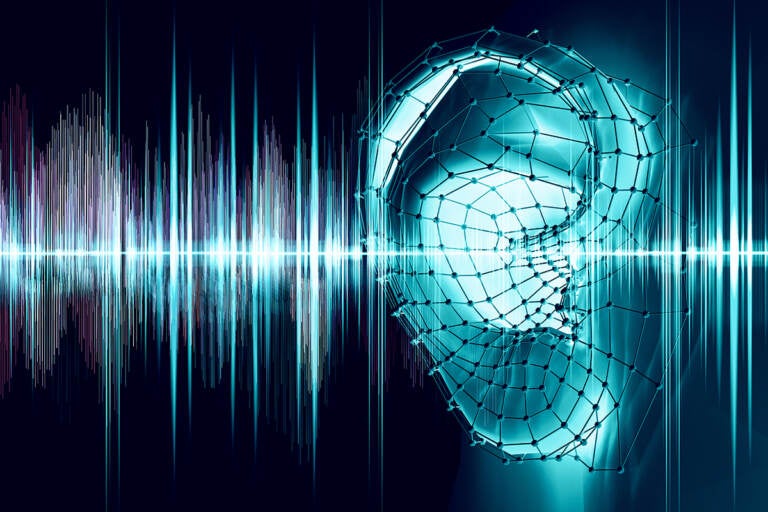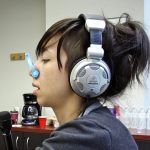Trouble understanding, but your hearing checks out fine. What’s at play?
Researchers are strategizing ways to discover whether auditory processing disorders are at play.
Listen 12:24
Auditory processing disorder refers to any failure along the pathway, from our ears into our brains. (carloscastilla /bigstock)
This story is from The Pulse, a weekly health and science podcast.
Find it on Apple Podcasts, Spotify or wherever you get your podcasts.
When Lindsey Jorgensen’s husband, Kyle Jorgensen, returned from a deployment to Afghanistan in 2007, she quickly noticed that he was having trouble hearing — or so it seemed.
“Particularly in loud situations like a restaurant, or when we would be anywhere like the zoo or something like that,” Jorgensen recalled.
Jorgensen is an audiologist who teaches at the University of South Dakota and works with patients who are hard of hearing.
She brought Kyle in for a hearing test.
“I put him in the test booth, and he had perfectly normal hearing on that traditional ‘push the button when you hear the beep’ exam.”
It didn’t make any sense. Soon, Jorgensen realized that it wasn’t just her husband. She worked at the Pittsburgh VA at that time, and she started noticing more and more veterans who said they had hearing loss — but whose tests were coming back normal. Jorgensen says there was even some suspicion that some of them might be faking it.
“We thought, well, maybe it was for a compensation and workman’s comp claim against the Department of Defense,” Jorgensen said. “When in reality, I really think that it was much, much more than that — that they are experiencing hearing loss. But our traditional testing is not capturing that.”
What was really going on: auditory processing disorder
Jorgensen wasn’t the only one noticing this problem. In a study published in 2012, researchers at the Portland, Oregon VA made a big discovery: that veterans who had been exposed to high-intensity blasts — on the order of improvised explosive devices and rocket-propelled grenades — were three times as likely to have a condition called auditory processing disorder.
“Auditory processing disorder is a very controversial topic in the field of audiology because not all audiologists really believe that it’s an auditory problem,” said Erick Gallun, one of the authors of that study. “And so one of the things that people are trying to figure out is, where do these difficulties arise?”
Traditional hearing loss, Gallun said, is often associated with damage to the cochlea, a hollow, spiral-shaped bone in the inner ear that transforms sound into electrical signals that then travel to the brain. From an anatomical perspective, the cochlea is the last stop on the hearing highway — except, Gallun said, it’s not.
“It turns out that there are still many, many stages, seven or eight, between the auditory nerve and understanding speech or knowing where in the world things are located,” he said.
Auditory processing disorder refers to any failure along that pathway, from our ears into our brains.
“And so you can argue about where does hearing end and cognition begin,” Gallun said. “But as a cognitive psychologist, I think of the entire system as listening, hearing, attending, being aware of the auditory world, communicating — these are the things that we want to do as human beings, and any patient that’s having trouble. I want to figure out why.”
Gallun said this type of problem could be related to traumatic brain injuries, which would explain why it seems to be more common among veterans. It has also been observed in people with concussions, he said. But how do you figure out where exactly the problem lies? Which step — between hearing sound, sending signals to the brain, and processing the information — has been compromised?
That was the big question researchers wanted to get to the bottom of — because you can’t solve someone’s hearing problem without knowing what’s causing it. What they needed was a better test — one that didn’t stop at the ear, but ventured into the brain.
Subscribe to The Pulse
What traditional tests miss
One of the most common frontline hearing assessments is the pure tone test — which usually involves sitting in a quiet space, and raising a hand or pressing a button when you hear a tone.
But Aaron Seitz — a professor of psychology at the University of California Riverside, and research partner with Erick Gallun — says these tests aren’t a great way to figure out whether someone has an auditory processing disorder.
“It’s in a very simple environment, where you’re able to spend all of your attention resources trying to do well in this test,” Seitz said. “You think about talking with someone at a restaurant or a Zoom meeting, and that there are other people talking, there’s other noises, maybe you have a pet or a child that wants your attention while you’re trying to focus on this conversation. And the complexity is so much different than that audiological testing.”
The “hear beep, push button” kind of test is what most audiologists are trained to give, but researchers like Gallun and Seitz believe they need something different to confirm whether someone has auditory processing disorder and zero in on what is causing the problem.
A few years ago, Gallun and Seitz developed a game called “Listen: An Auditory Training Experience.” It’s available to download for free in both the Apple and Google app stores.
Players move little orbs of light traveling through the forest. Every so often, a green squiggly line appears that the players have to dodge, then figure out if they’re hearing tones in their right or left ears and move accordingly.
The tones were developed to stimulate different filters the brain has for processing different sounds. By seeing which tones a player misses, the researchers can identify which filters aren’t working. And the game gets harder as you play — they make the tones quieter, add background noise, or reduce the signal. That way they can measure not only which filters are working, but how well they’re working. The game then tailors the challenges to the player’s weaknesses, to help them “exercise” whatever filters aren’t doing so well.
Gallun and Seitz said they want to train people’s hearing in a way that isn’t stressful or anxiety-inducing, but, they hope, kind of fun.
The game is still in development — so far, about 100 people have played it, across different versions. That’s a small number, but the results are encouraging. After 20 sessions of game play, they found that people’s hearing was improved, compared with a control group.
Audiologist Lindsey Jorgensen has recommended the game to patients, and they say it’s helped. She’s also been deploying other strategies for helping veterans with auditory processing disorder — many of which she’s tested on her husband. They involve listening to conversations with increasing amounts of distracting background noise, and trying to understand what is being said.
Exercises help, and so does empathy.
“My job is about 50% hearing aids, 50% marital counseling, right? I think that when it helps the most is when it is a combination of the veteran doing something like these games and then also with the significant other or primary communication partner really understanding good communication techniques,” Jorgensen said.
Things like talking more slowly, and giving context — introducing a topic before you launch into something, and making sure the other person can see your face and lips as you talk.
WHYY is your source for fact-based, in-depth journalism and information. As a nonprofit organization, we rely on financial support from readers like you. Please give today.







